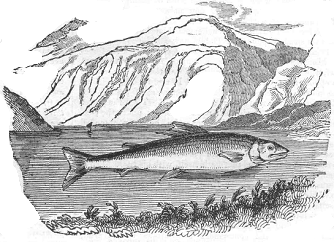The Char – or Salmo Alpinus
[From the Dublin Penny Journal, Vol. 1, No. 17, October 20, 1832]
Some years ago it was not suspected, nor is it yet generally believed, that the char is an inhabitant of most of the mountain lakes of Ireland. Dr. Smith was the first to notice its existence in two of the small lakes in the Cummeragh mountains, in the county of Waterford, one of which we have given a view of in our present number. He describes the char of these lakes as about two feet long, the male grey, and the female yellow-bellied; and the flesh, he adds, is as red and curdy as a salmon, and eats more delicious than any trout. Notwithstanding this account of Dr. Smith, the great traveller and naturalist, Pennant, did not believe in its existence in Ireland, a circumstance the more extraordinary, considering that he made a tour, as he says, in "that hospitable kingdom, and travelled from Dublin to Ballycastle, the Giant's Causeway, Coleraine, the extremity of the county of Donegal, Londonderry, Strabane, Enniskillen, Galway, Limerick, the Lakes of Killarney, Kinsale, Cork, Cashel, Waterford, Kilkenny, and Dublin." But the mystery of his ignorance is explained by himself. "Such," he states, "was the conviviality of the country, that my journey proved as maigre, as my entertainment was gras, so it never was a dish fit to be offered to the public."
The char was next stated to he found in one of the lakes of Donegal - Lough Esk - by Mr. Wilson, the author of the Irish Post-Chaise Companion. He describes it as a most delicate fish, and generally about nine inches long. He adds, that they are not to be caught by bait, but feeding in deep water, are only taken in nets.
Their existence in Ireland was at length put beyond dispute by the celebrated naturalist, the late Mr. Templeton, of Belfast, who, in an able article addressed to the author of the Antrim Survey, established the facts of their being found in Lough Egish, in Fermanagh, and Lough Neagh, and of their identity with the char of Windermere and Wales. Of the examples which fell under his observation, he gives the following account: -
"They are generally about twelve inches long, though I have seen one of fifteen.
The nostrils double.
Teeth in the jaws, roof of the mouth, and on the tongue.
Back, dusky brown; sides, pale reddish brown, with small spots of bright bay; bellies white, with a tinge of reddish.
First dorsal fin 11 rayed.
Second very small.
Pectoral 11 rayed. The first complete ray of each strong
Ventral and anal 8. and white."
The char was next noticed as existing in Lough Dan, one of the Wicklow lakes, by Wright, in his Guide to that County; but he states that their existence in any of the other lakes of that county, is not known. The fact, however, is well known to sportsmen of their being found in Luggelaw and the lakes of Glandalough, in which, however, their greatest size does not exceed seven inches.
Both Pennant, Wilson, and Templeton, erred in supposing that the char could only be taken by nets, in consequence of the deep water which they inhabit. They are sometimes taken in shallow water, and both with fly and minnow, in the county of Wicklow, and latterly at Coniston-Water, in Cumberland, -

Char, with View of Lough Dan.
a mode introduced there from Ireland by an Irish gentleman: the fly should be small and of a gaudy colour.
"The char," says Sir Humphrey Davy, "is always in its colour a very brilliant fish, but in different countries there are many varieties in the tint." Those of the Wicklow lakes are of a bluish black on the back, and on the belly, silvery, with a slight tinge of red - the pectoral fins of a decided red.
It is a curious and interesting fact that, the char of Lough Dan have been found during this summer in great quantities on the surface of the lake, dead or dying.
P.
